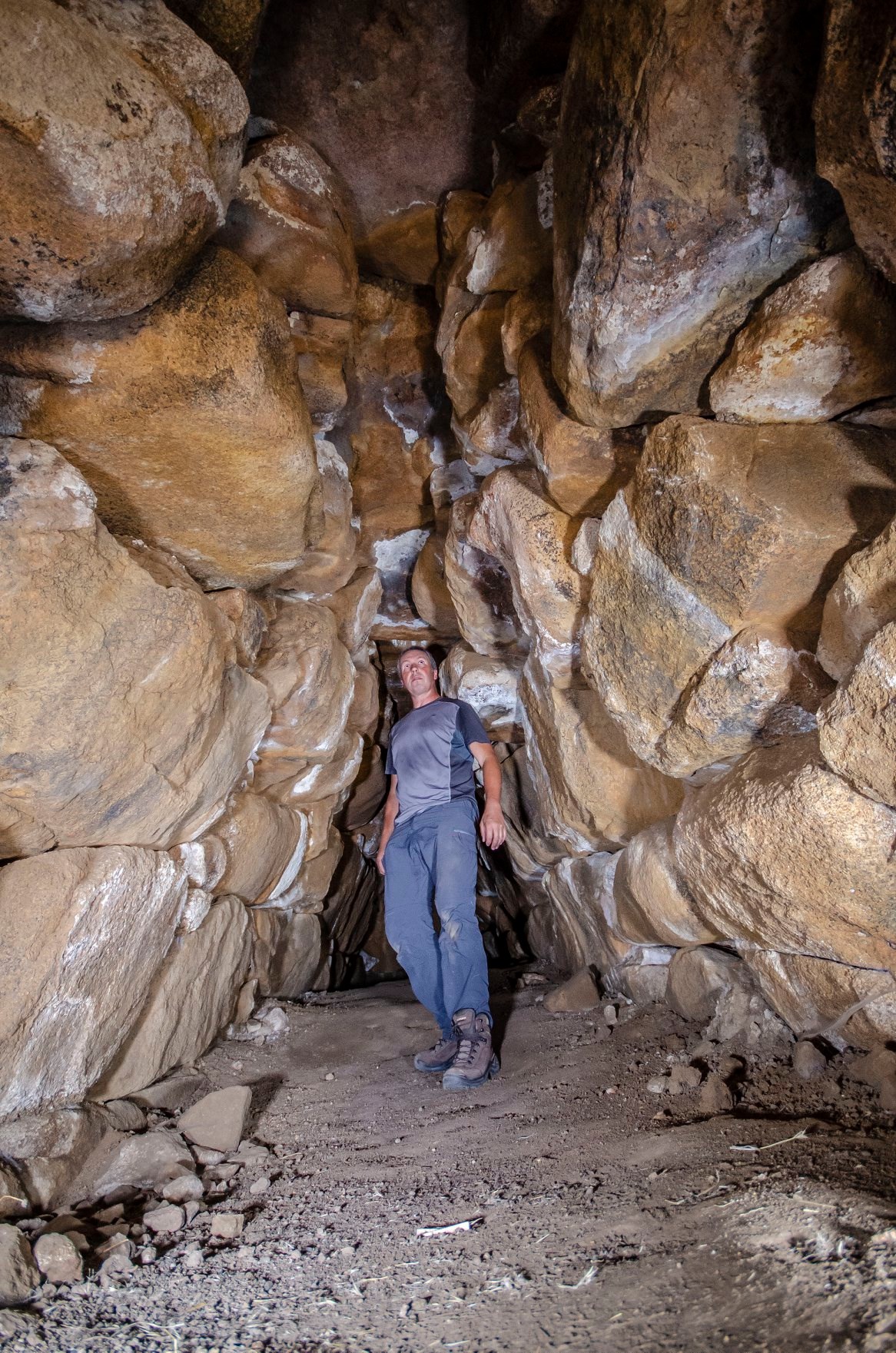There is a reasonable analogy between the facade of the central stele of the dolmenic type giant tombs and the section of a female reproductive system, considering that the planimetric profile of several TdG can be likened, according to a rather widespread opinion, to the maternal womb. The small betili often found near the “portal” at the base were presumably used to mimic acts of copulation during ceremonies related to the regeneration of life and fertility.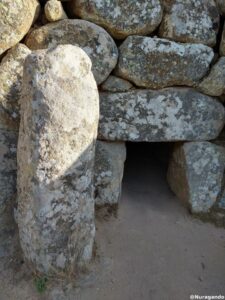 The same small door, generally of reduced dimensions and therefore unsuitable for the passage of people and the corpses to be buried, would thus assume a symbolic meaning similar to that of the entire stele, with the upper portion representing the “round of the uterus” (cut), the rectangular section below the “uterine-vaginal” band, while the wider section would reproduce the vagina with the “vestibule” at the base. It is also singular to observe that there is a type of traditional bread called “Su Càbude” from Mores, whose shape precisely resembles a central stele of the tombs of the giants (In the second image, two traditional breads, the central stele of a tomb of giants, and a uterine section are depicted).
The same small door, generally of reduced dimensions and therefore unsuitable for the passage of people and the corpses to be buried, would thus assume a symbolic meaning similar to that of the entire stele, with the upper portion representing the “round of the uterus” (cut), the rectangular section below the “uterine-vaginal” band, while the wider section would reproduce the vagina with the “vestibule” at the base. It is also singular to observe that there is a type of traditional bread called “Su Càbude” from Mores, whose shape precisely resembles a central stele of the tombs of the giants (In the second image, two traditional breads, the central stele of a tomb of giants, and a uterine section are depicted).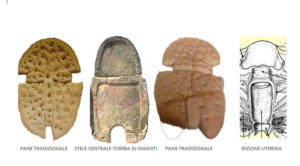 This bread, described and illustrated by Salvatore Dedola in his book “I pani della Sardegna”, was usually crumbled on the head of the male child or, in a very similar version called “affesta”, crumbled on the head “of the daughter who is getting married”, and even in the field or in the sheepfold “as a gesture of good omen for future harvests and future offspring.”
This bread, described and illustrated by Salvatore Dedola in his book “I pani della Sardegna”, was usually crumbled on the head of the male child or, in a very similar version called “affesta”, crumbled on the head “of the daughter who is getting married”, and even in the field or in the sheepfold “as a gesture of good omen for future harvests and future offspring.”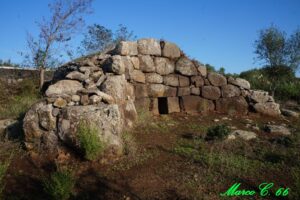 Having said that, I wondered whether the meaning that I seemed to identify in the various elements of the dolmenic TdG and more generally in their overall structure could also be found in those of the cyclopean type, such as those of “Is Concias” in Quartucciu and “Mura Cuada” in Paulilatino, which do not present any central stele but only the lower opening (at Is Concias, a small betile is also clearly visible next to the base door).
Having said that, I wondered whether the meaning that I seemed to identify in the various elements of the dolmenic TdG and more generally in their overall structure could also be found in those of the cyclopean type, such as those of “Is Concias” in Quartucciu and “Mura Cuada” in Paulilatino, which do not present any central stele but only the lower opening (at Is Concias, a small betile is also clearly visible next to the base door). I was able to obtain a confirmation, however tenuous, of this hypothesis from reading a note that I had accidentally found on the web eight years ago, published by Marco Piras (Meggen, Luzern March 2006), of which I report, below, some significant passages: “Having to prepare lessons for a Master at the University of Cagliari and re-listening to the tapes I recorded during a survey conducted in 1984, in the Sulcis area, I stumbled upon an interview with a 96-year-old man from Santadi. Moreover, this very brief interview, I had never used for my phonetic and phonological studies due to the poor sound quality, both because the elderly man’s pronunciation was terrible and because the interviewee did not always respond appropriately. Consequently, I had limited myself to conducting an open discussion on what he liked, and among other things he had indulged in listing insults, curses, invectives, etc. Among the numerous varieties concerning “su cunnu” that he had unraveled and which are partly reported above, one had completely escaped me and at the moment had not evidently struck me, perhaps precisely because of the little attention I had paid to this informant and the little attention my research paid to the lexical aspect. Torradìnc in su cunn (..) perda. The poor quality of the recording and the pronunciation, moreover obscured by a throat clearing, may support a realization of torradìnc in su cunn and pèrda, “go back to the stone vagina.”
I was able to obtain a confirmation, however tenuous, of this hypothesis from reading a note that I had accidentally found on the web eight years ago, published by Marco Piras (Meggen, Luzern March 2006), of which I report, below, some significant passages: “Having to prepare lessons for a Master at the University of Cagliari and re-listening to the tapes I recorded during a survey conducted in 1984, in the Sulcis area, I stumbled upon an interview with a 96-year-old man from Santadi. Moreover, this very brief interview, I had never used for my phonetic and phonological studies due to the poor sound quality, both because the elderly man’s pronunciation was terrible and because the interviewee did not always respond appropriately. Consequently, I had limited myself to conducting an open discussion on what he liked, and among other things he had indulged in listing insults, curses, invectives, etc. Among the numerous varieties concerning “su cunnu” that he had unraveled and which are partly reported above, one had completely escaped me and at the moment had not evidently struck me, perhaps precisely because of the little attention I had paid to this informant and the little attention my research paid to the lexical aspect. Torradìnc in su cunn (..) perda. The poor quality of the recording and the pronunciation, moreover obscured by a throat clearing, may support a realization of torradìnc in su cunn and pèrda, “go back to the stone vagina.”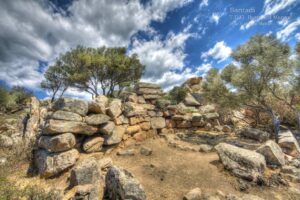 But one could also hear a Torradinci in su cunn e sa perda (go back to the vagina of the stone). Even the listening proposed to other phonetic friends did not provide any other possible interpretations. After some time, while reflecting on the beautiful publication by Gimbutas, a fantasy suddenly struck me, or rather an association of ideas. “What if the possible vagina of stone (assuming I have correctly deciphered the old man’s phrase) were the domu de janas or the tomb of the giants, or both? At the first opportunity I had to return to Sardinia, although I did not expect to find my informant still alive after 20 years, I wanted, through direct and indirect questions, to try to confirm my hypothesis. I found the only living son of my informant, over eighty years old, unfortunately not very attentive, deaf, and with severe articulation difficulties. I would have liked to have him list the invectives in which the word cunnu appeared that he knew, but in the meantime, I could not make him understand what I desired, and in any case, it was almost torture to make him speak. I had no choice but to proceed with direct references to the invective heard from the father’s voice, and so I played at full volume the part where the father spoke of “su cunn ‘e sa pèrda” if that was how it was to be understood. I asked him if he knew the expression su cunn ‘e ssa pèrda. Methodologically, this is not very correct, but the informant’s condition did not allow for anything else. He nodded. I repeated to him in Sardinian: your father said “su cunn’e sa perda,” have you ever heard it?” He kept nodding.
But one could also hear a Torradinci in su cunn e sa perda (go back to the vagina of the stone). Even the listening proposed to other phonetic friends did not provide any other possible interpretations. After some time, while reflecting on the beautiful publication by Gimbutas, a fantasy suddenly struck me, or rather an association of ideas. “What if the possible vagina of stone (assuming I have correctly deciphered the old man’s phrase) were the domu de janas or the tomb of the giants, or both? At the first opportunity I had to return to Sardinia, although I did not expect to find my informant still alive after 20 years, I wanted, through direct and indirect questions, to try to confirm my hypothesis. I found the only living son of my informant, over eighty years old, unfortunately not very attentive, deaf, and with severe articulation difficulties. I would have liked to have him list the invectives in which the word cunnu appeared that he knew, but in the meantime, I could not make him understand what I desired, and in any case, it was almost torture to make him speak. I had no choice but to proceed with direct references to the invective heard from the father’s voice, and so I played at full volume the part where the father spoke of “su cunn ‘e sa pèrda” if that was how it was to be understood. I asked him if he knew the expression su cunn ‘e ssa pèrda. Methodologically, this is not very correct, but the informant’s condition did not allow for anything else. He nodded. I repeated to him in Sardinian: your father said “su cunn’e sa perda,” have you ever heard it?” He kept nodding. I asked him, “What is su cunn e sa perda?” The person hinted at a distant place but couldn’t explain more. The son, who was disinterestedly listening to the conversation, almost annoyed because he was waiting for me to leave so he could finally take care of some business, told me that I wouldn’t get anything out of it, and made me understand that, poor thing, the father wasn’t entirely in his right mind: “Léi ca non di òga suppa”, “Badi che non ne cava nulla”. But, with my insistence, and with the help of this son, I understood that the old man wanted to take me to some point in the countryside. In my car, indicating to me when necessary where to go, we arrived at the hamlet of Terresòli and at the foot of a hill, at a point where we could not continue by car, he pointed me in a direction. The man was unable to take more than a few steps. So it was impossible to be guided. I didn’t get any more out of it. However, in that direction is the location “Barràncu mannu” where a tomb of the giants is located. After obtaining a Polaroid, the next day I photographed the tomb of the giants and returned to the informant who, evidently, still had enough sight to recognize the object, and to my question if that was su cunn e sa perda he confidently replied yes. All this is not considered absolutely conclusive evidence. What is certain is that it should be an incentive for researchers to investigate in this regard, in other parts of Sardegna verso l’unesco, both in terms of linguistic and anthropological aspects in general.
I asked him, “What is su cunn e sa perda?” The person hinted at a distant place but couldn’t explain more. The son, who was disinterestedly listening to the conversation, almost annoyed because he was waiting for me to leave so he could finally take care of some business, told me that I wouldn’t get anything out of it, and made me understand that, poor thing, the father wasn’t entirely in his right mind: “Léi ca non di òga suppa”, “Badi che non ne cava nulla”. But, with my insistence, and with the help of this son, I understood that the old man wanted to take me to some point in the countryside. In my car, indicating to me when necessary where to go, we arrived at the hamlet of Terresòli and at the foot of a hill, at a point where we could not continue by car, he pointed me in a direction. The man was unable to take more than a few steps. So it was impossible to be guided. I didn’t get any more out of it. However, in that direction is the location “Barràncu mannu” where a tomb of the giants is located. After obtaining a Polaroid, the next day I photographed the tomb of the giants and returned to the informant who, evidently, still had enough sight to recognize the object, and to my question if that was su cunn e sa perda he confidently replied yes. All this is not considered absolutely conclusive evidence. What is certain is that it should be an incentive for researchers to investigate in this regard, in other parts of Sardegna verso l’unesco, both in terms of linguistic and anthropological aspects in general.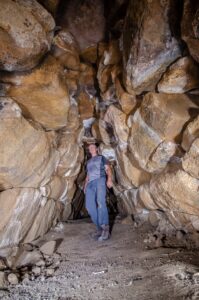 The photos of the giant’s tomb of Barrancu Mannu in Santadi are by Giovanni Sotgiu and Sergio Melis. Those of the giant’s tomb of Is Concias in Quartucciu are by Valentino Selis and Nuragando. The photo of the giant’s tomb of Mura Cuada in Paulilatino is by Marco Cocco.
The photos of the giant’s tomb of Barrancu Mannu in Santadi are by Giovanni Sotgiu and Sergio Melis. Those of the giant’s tomb of Is Concias in Quartucciu are by Valentino Selis and Nuragando. The photo of the giant’s tomb of Mura Cuada in Paulilatino is by Marco Cocco.
